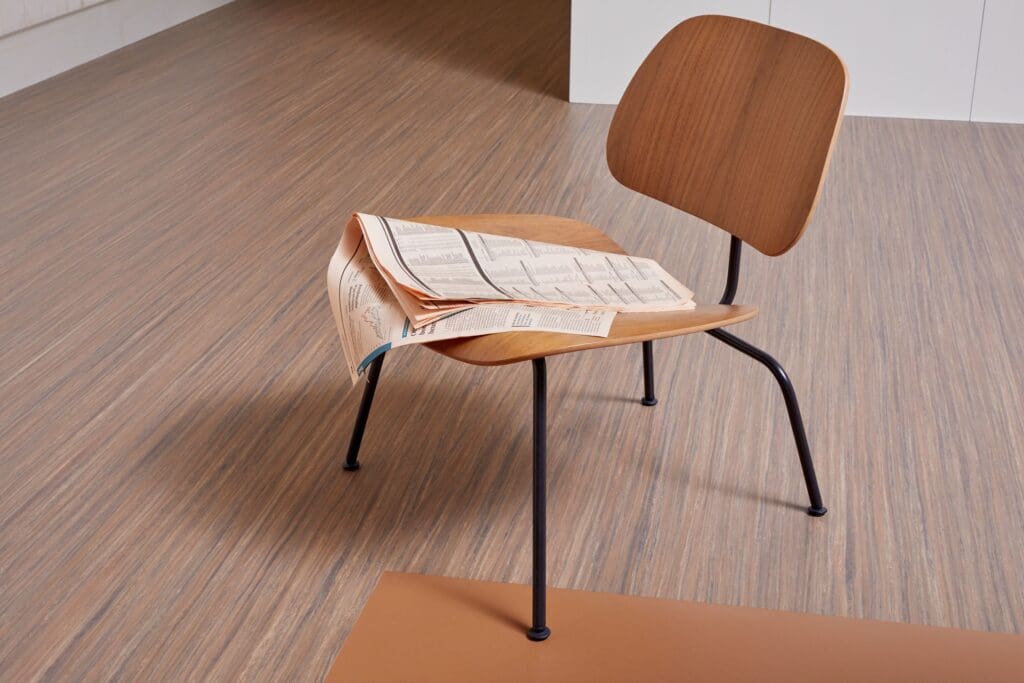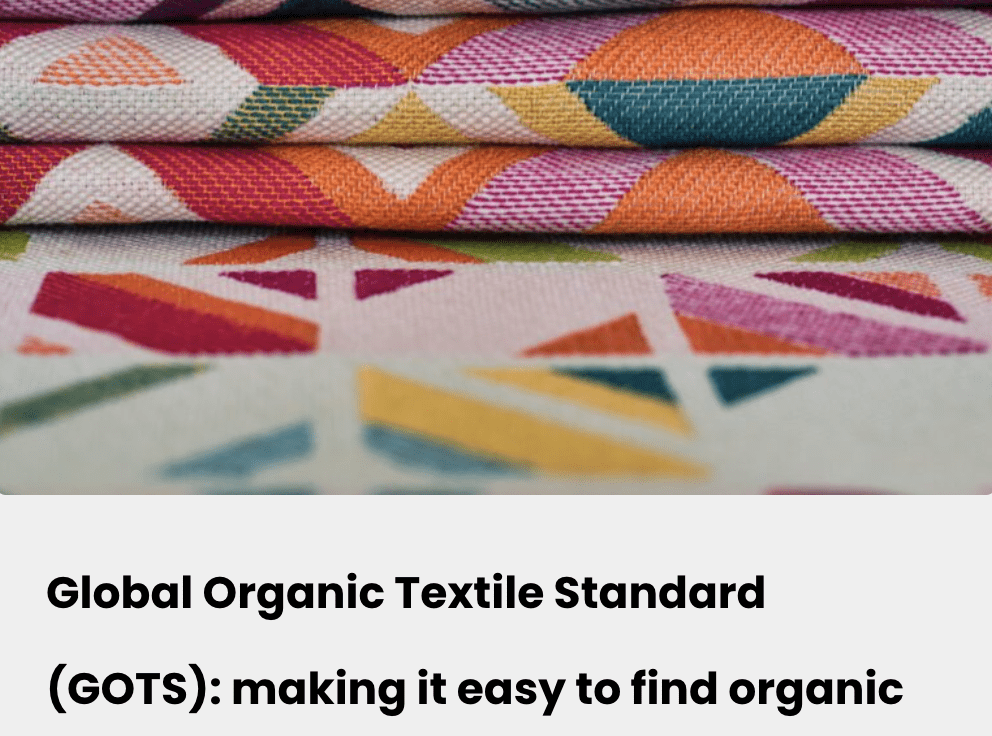In this post, we share a review of our experience installing linoleum flooring. We selected eco-friendly Marmoleum manufacturer by Forbo. Image above courtesy of Forbo.
The Home Green is reader-supported and may receive a commission if you decide to make a purchase through a posted link, at no cost to you.
The situation: in search of basement flooring
About a year ago, we decided to create a play space where our daughter and her friends could get a little wild without adults hovering. (I painted that altruistically – we really just wanted to regain a little quiet…)
In our part of the U.S., it’s common for homes to come with basements and many have become subterranean bunkers where kids have free reign. While our 1950s basement is less than ideal as a living space – it doesn’t have high ceilings or natural light – we felt like we could carve out a corner suitable enough for boisterous children.
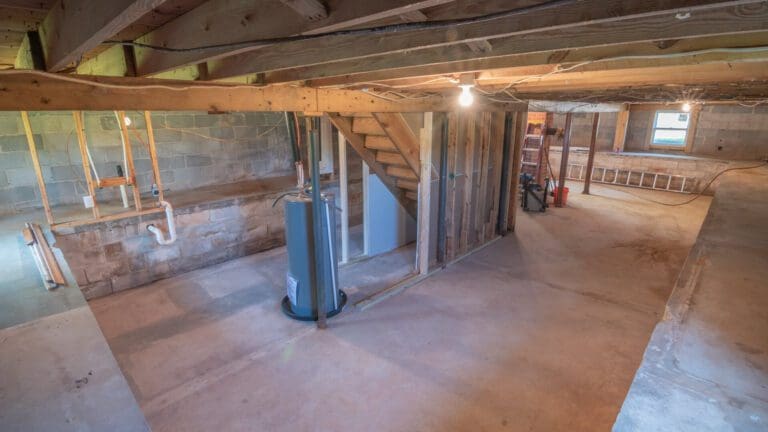

I’m lucky that my husband is handy and was able to do most of the work himself. When it came time to put the flooring, however, we were stuck. Since this was more or less a rec room, we didn’t want to invest in a really expensive material. In addition, many materials like hardwood are not typically recommended for the conditions of a basement, anyway.
We came across many sources recommending vinyl flooring, but I wasn’t into that. A few years back, we refinished another space in our home and went with the sales rep’s recommendation of luxury vinyl flooring. I was happy with the versatility of the material and price point and didn’t research it any further than that. Fast forward to learning more about vinyl flooring and the potential negative impacts it can have during manufacturing, installation, and eventual disposal and I wish I had made a different choice.
This time around, we dug deeper to understand what other materials had a decent price point but a lighter environmental footprint. We were surprised to repeatedly come across linoleum flooring as a recommendation. I kept thinking back to those colorful tiles I remember from elementary school – was it possible that anything from my childhood was eco-friendly? (spoiler alert: yes!)
Just what are linoleum floors?
Linoleum is made using a combination of linseed oil, cork dust, and wood flour. Not only does it have natural origins, but it is also durable and can last for decades. Plus, it has a reasonable price point – hence why it has been used in so many commercial and cost-focused spaces.
One of the things that makes linoleum flooring confusing is that it’s an often misused term. Just googling linoleum flooring will give you plenty of results for products that are not actually linoleum. Because linoleum was the first broadly available product in a category now known as resilient flooring, flooring that has some give and bounces back with pressure is applied, it is often thought of as a word that represents that entire category. In reality, linoleum is a specific kind of flooring product and is quite different from the vinyl products that are often referred to as linoleum.
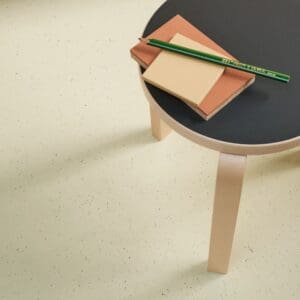

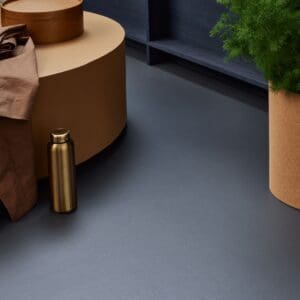



Linoleum flooring images courtesy of Forbo
What's the difference between linoleum and vinyl flooring?
One of the products that is most often mistakenly referred to as linoleum is vinyl flooring. They are, in fact, quite different products. Some key differences include:
Material Composition
- Vinyl flooring is made of synthetic materials, primarily polyvinyl chloride (PVC) which is plastic. It often includes layers like a wear layer, printed design layer, and backing.
- Linoleum flooring is made from natural materials such as linseed oil, cork dust, wood flour, tree resins, and mineral pigments. Linoleum is considered more environmentally friendly.
Durability
- Both are considered highly durable and recommended for high-traffic areas.
- Vinyl flooring is typically resistant to water.
- While linoleum flooring is designed to be resistant to water, many distributors and installers comment that it is not ideal for places with pooling water that might not be mopped up quickly (like a child’s bathroom). If left to soak in water, the natural wood component can absorb water and swell.
Environmental Impact
- Due largely to the use of PVC, which may release harmful compounds in manufacturing and/or at home, the sustainability of vinyl flooring can be questionable. Research is required to understand the environmental impact of a specific type or manufacturer.
- Linoleum flooring is generally considered environmentally friendly because it is made from renewable resources and biodegradable materials. Manufacturers specify that it doesn't emit harmful Volatile Organic Compounds (VOCs).
Appearance and Design
- Vinyl flooring is available in a range of design options, including wood and stone patterns.
- When it comes to linoleum flooring manufacturers also offer a variety of options including bright colors and more natural wood tones.
Installation
- Both vinyl flooring and linoleum come in tiles or large sheets. While many of the tiled versions can be installed without professional help, sheets are typically installed by an experienced flooring specialist.
Cost
- Both materials have a wide range of prices depending on material and style but are typically less expensive than hardwood flooring.
Making a final decision
When we considered our options, we felt like on paper, linoleum was our best option largely due to it being the more eco-friendly flooring option. I still had some skepticism, however, about the appearance of linoleum. While we planned to use this in a basement space, I still had some aesthetic standards and the ketchup and mustard tiles from my elementary school memory were not what I had in mind.
With my attitude firmly set in a zone of skepticism, I looked online and found that linoleum is manufactured by several different companies including a direct-to-consumer seller called Forbo who sells a linoleum product branded as Marmoleum.
We liked that their product was made in long, plank-like tiles instead of a big sheet. This felt more approachable for a normal DIYer and also meant that if the flooring suffered damage in the future, we could replace just one tile. Additionally, we loved that these tiles snapped together and didn’t require any adhesives which felt like they would be messy and potentially toxic.
Our final consideration was the price. Our Marmoleum flooring came in at $5.99/square foot which was slightly more than the vinyl we regret installing. While this was a slightly bigger investment, we felt like it was worth the extra money both because of its eco-friendliness and also for our own peace of mind since the space where it was being installed would be used primarily by children.
Sampling and ordering our linoleum flooring
With our concerns about the material itself addressed, we were ready to take a look at the actual product. We looked at all of the color choices offered in the Marmoleum flooring lineup, ordered a box of Cliffs of Moher, and awaited its arrival.
One thing to note, while we ordered our Marmoleum from the Home Depot, Green Building Supply is another great source to investigate. If you’re having trouble deciding between the various colors offered, they can send you a kit that contains a small sample of each option. When you’re done, you send it back in a prepaid return package.


Marmoeum aesthetics
The Marmoleum tiles arrived well-packaged and we were surprised by how heavy the box was. Once we opened it up, my first priority was to check out the color and appearance. To me, the actual tile looked slightly lighter and maybe more gray versus what I had imagined based on the image online but this was fine for our space.
Next, we examined the quality of the tile and simulated how the finished product would look by lining up several in a staggered configuration. Comparing the Marmoleum to the vinyl that we installed a few years back, this product was thicker and more substantial and had a softer and less rigid feeling. While not exactly like a wood flooring plank, it had a more natural feeling.
We talked it over and decided Marmoleum looked like the solution for our needs. After doing some measurements and adding on a 10% materials buffer, we put in our order.
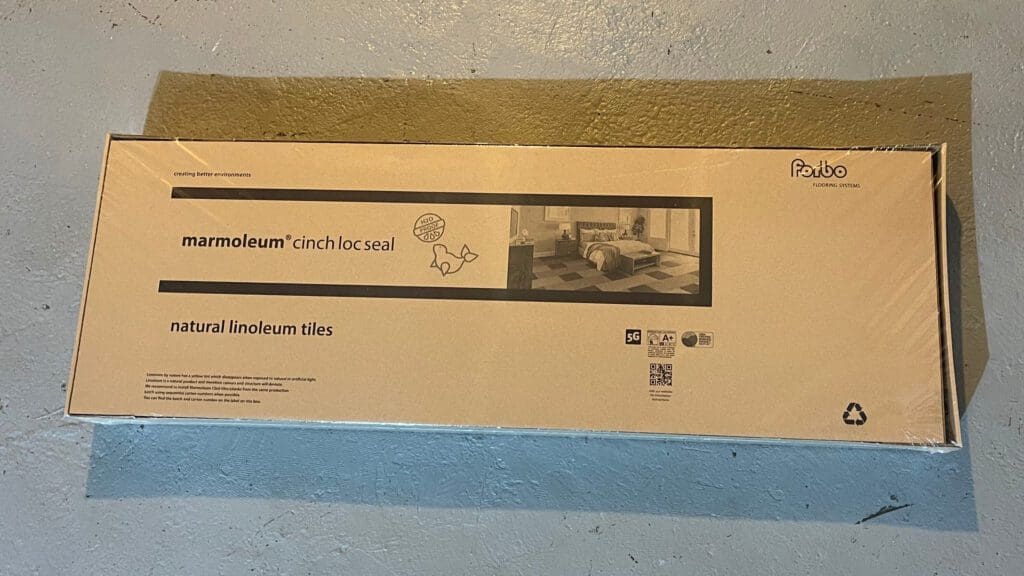

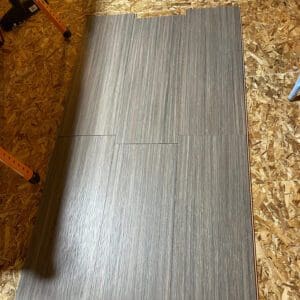

Linonleum flooring installation
Finally, installation day had arrived! The tiles we ordered are the ones specified with the Click Cinch LOC seal and the installation was as straightforward as promised. (Instructions from Forbo can be found here).
Each tile locked into place quite easily and only required a light tap with a rubber mallet every now and again to keep everything tight. One thing to note, we did not use the cork underlayment offered by Forbo so cannot comment on that part of the installation.
Overall, if you’ve ever installed another type of flooring, or even if you haven’t, it’s a relatively easy process – no adhesives or nailing was required. The same core principles of installing any type of flooring carry over to Marmoleum flooring. These include things like staggering the tiles so that the short end of the tile doesn’t match up to its neighbor, leaving an expansion buffer around the perimeter of the room (about ½” in this case), and running the tile to match the length of the room.
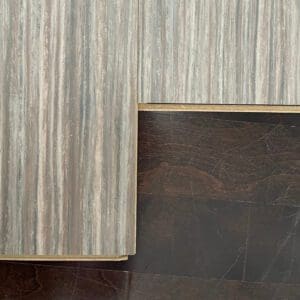

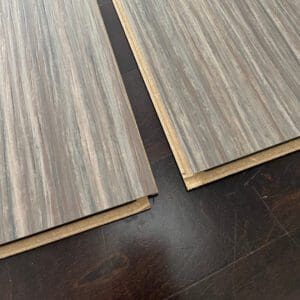

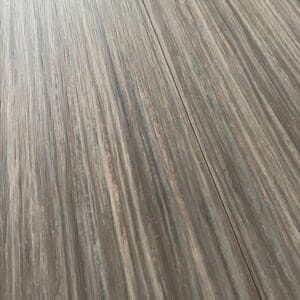

The final linoleum floor
We are really happy with our choice of Marmoleum flooring. It meets our needs of being durable, compatible with more humid basement conditions, and affordable. We like the way it looks, it feels great underfoot, and was easy to install. It shows no signs of having issues with normal wear and tear, but we’ll be sure to update this review once it’s sustained a little more abuse.
We hope this helps you better understand if natural linoleum could be a good flooring solution for your home! See our FAQs below for commonly asked questions and reach out if something’s not covered!


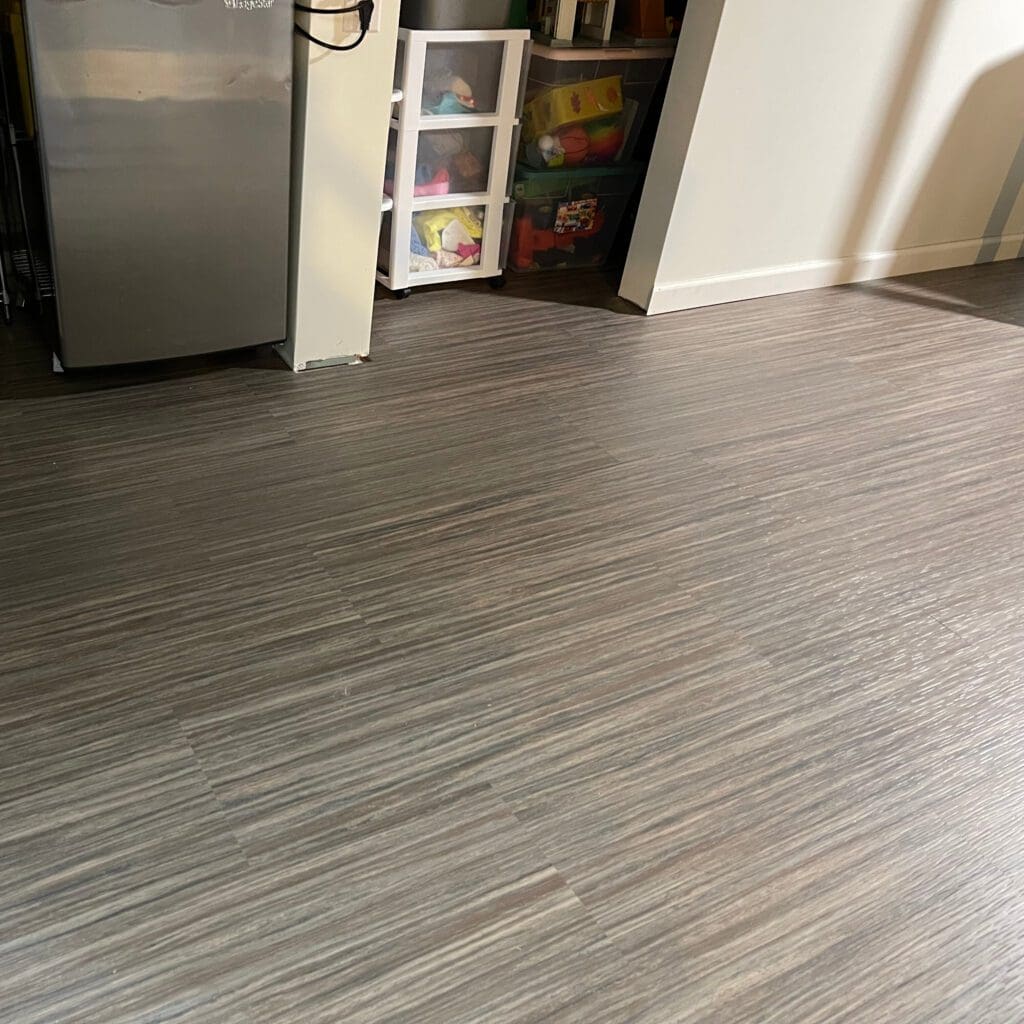

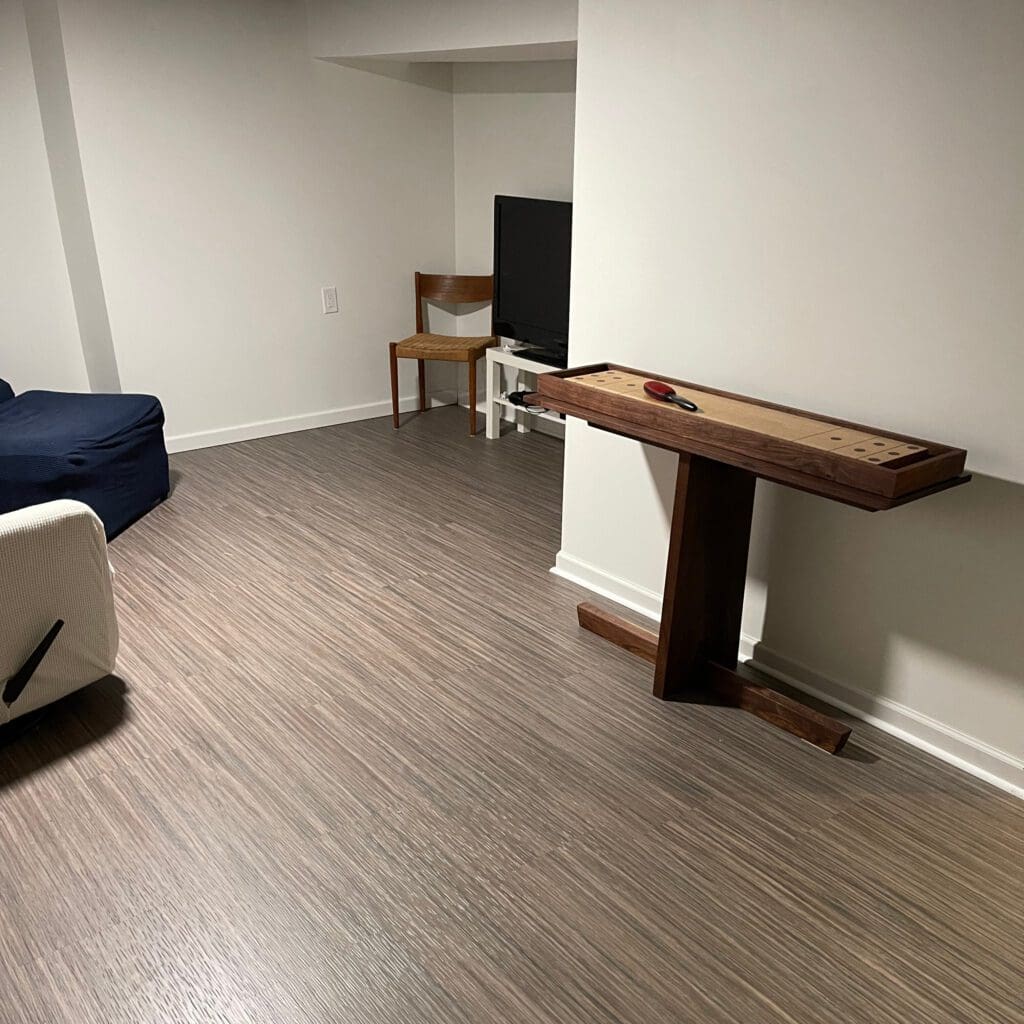

The final flooring! The space is still a work in progress and I need to figure out how to get some pictures with better light but hopefully, this gives you a sense of how it looks.
FAQs about linoleum flooring
What is Marmoleum flooring?
Marmoleum is a brand name for a type of flooring product that falls under the category of linoleum. The term “Marmoleum” is often used interchangeably with linoleum, but it specifically refers to linoleum flooring produced by Forbo Flooring Systems.
Some characteristics of Marmoleum include:
- Natural – Like traditional linoleum, Marmoleum is made from natural and renewable materials. It typically includes linseed oil, wood flour, rosin, jute, and limestone..
- Customizable – Marmoleum is known for its wide range of design options. It comes in various colors and patterns, providing versatility for different interior design preferences.
- Durable – Marmoleum can withstand heavy foot traffic and is resistant to wear and tear.
- Eco-friendly – Not only is Marmoleum made from natural, renewable, and biodegradable materials but its manufacturer, Forbo, emphasizes environmentally responsible manufacturing practices.
- Antimicrobial – Some Marmoleum products have inherent antimicrobial properties due to the natural materials used in their composition.
- Low maintenance – Marmoleum is relatively easy to clean and maintain. Regular sweeping and occasional damp mopping are typically sufficient to keep it in good condition.
- Hypoallergenic – Similar to linoleum in general, Marmoleum is resistant to dust and allergens, making it a hypoallergenic flooring option.
Who sells linoleum flooring?
One of the great things about linoleum flooring is that it’s available from many retailers, so you have lots of options to consider. A few to consider include home improvement stores, independent eco-focused online retailers like Green Building Supply, online-only retailers like Amazon, or your local flooring specialty store. If you’re looking for installation, a local flooring store may be one of your best bets.
It may be helpful to know that linoleum flooring is sold under several different brand names. They include:
- Marmoleum, manufactured by Forbo
- Armstrong Flooring
- Tarkett
- Gerflor
- NovaFloor.
Which is the best linoleum flooring manufacturer?
There are a lot of factors to consider in determining which linoleum flooring manufacturer is the best for your situation. One of the first considerations is whether or not you're planning to install the flooring yourself. Many of the brands listed above are sold through distributors and flooring stores – check the manufacturer's website for more information on where and how you can purchase their products.
When shopping for linoleum, consider factors such as the brand reputation, product specifications, environmental considerations, and any certifications the product may have. If at all possible, interact with a sample in person before purchasing so you can get a sense of the look and feel of the product that will be in your home. You’ll also want to compare prices and understand what type of warranty comes with your flooring.
Finally, it's important to note that the availability of specific brands may vary by region, and new brands and product lines may emerge all the time. Check with local retailers, home improvement stores, or flooring specialty stores to explore the linoleum options available in your area.
Other articles you may enjoy
Free tips and inspiration in your inbox
Enter your email address below to receive the latest news from The Home Green.

